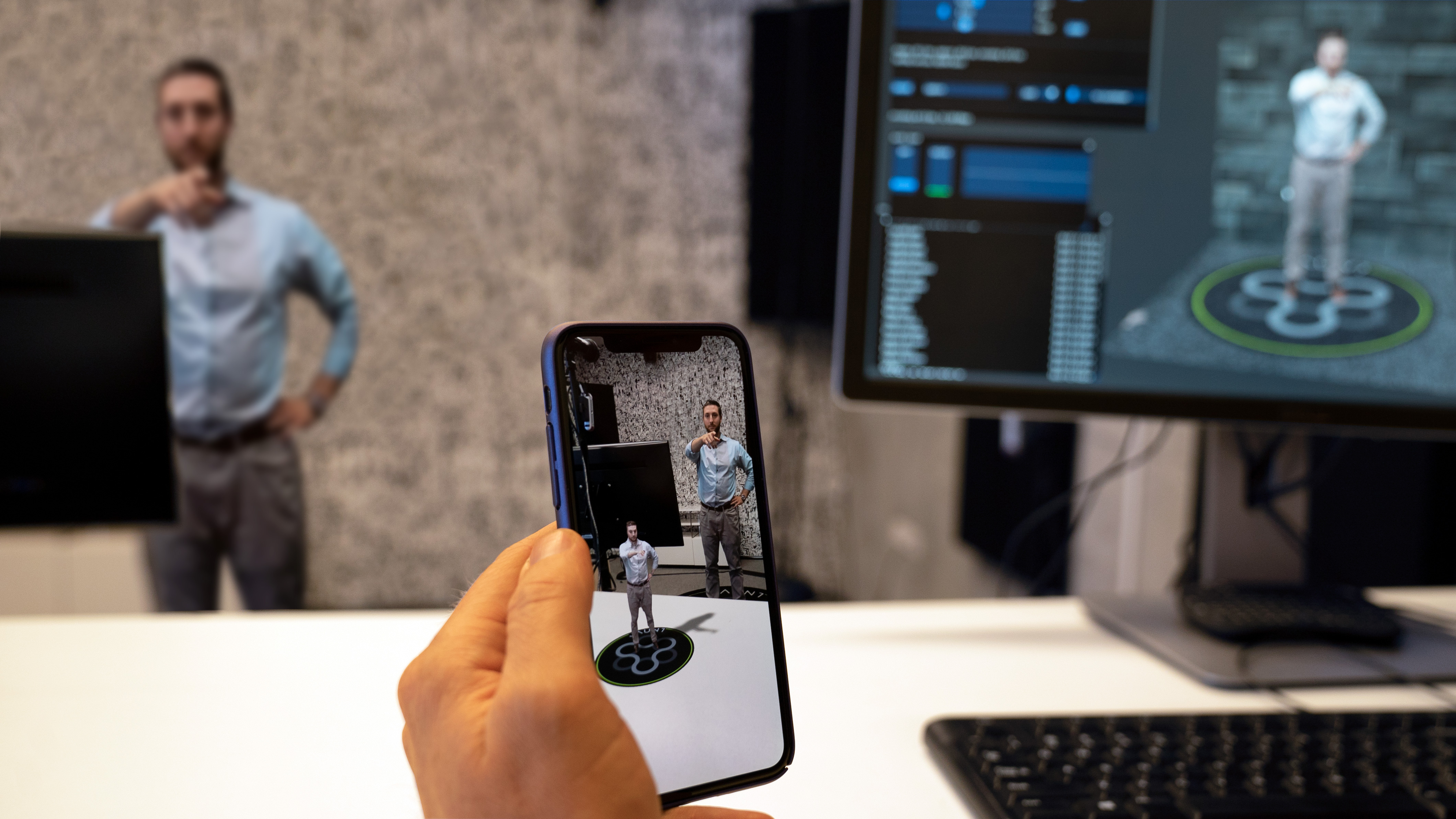 EMERGING TECH
EMERGING TECH
 EMERGING TECH
EMERGING TECH
 EMERGING TECH
EMERGING TECH
Virtual and augmented reality distribution company Jaunt Inc. has been working hard to push the envelope of what AR and VR can do, and on Thursday it announced a new research initiative that brings real-time AR streaming closer to practical use.
The company’s current research is into what is called “volumetric capture,” which is the ability to record and process everything that happens in a particular space from a 360-degree perspective.
In this case, Jaunt chose to work with a person to create a real-time streaming 3-D avatar that then mirrors the person’s appearance, movements and vocals as a sharable AR object.
The concept is outwardly simple: Have a person stand on a platform surrounded by cameras pointing inward. The subject can smile, turn around, scratch his or her nose, do jumping jacks or anything else that a normal 2-D camera setup could capture, except in this case the multiple cameras can produce a lifelike, real-time rendering of that person from all around them.
The result is that that person can then be projected, via both AR and VR, in a way that allows the viewer to walk around the subject’s avatar and see it from a 3-D perspective.
“At Jaunt, we’re always thinking about expanding the boundaries of storytelling by exploring the full immersive content spectrum; from virtual reality to augmented and mixed reality, volumetric and even new formats that our advanced development teams are working on,” said Arthur van Hoff, Jaunt chief technology officer and founder.
An easy-tounderstand example would be a teleconference where everyone can see a virtual presenter, perhaps the chief executive of a company, standing in front of a conference room demonstrating a project or mission plan. The 3-D avatar of the CEO could easily summon up other AR objects around her or even display physical objects brought into the camera platform with her, and as a result, these items would be to scale.
The same could be done for a presentation in VR, producing a greater fidelity for the speech because the 360-degree volumetric capture would authentically mimic her gestures and expressions. This would be true no matter what angle the audience sat at within a virtual auditorium or conference room, which would better relay the sense of “being there” than one fixed position.
According to van Hoff, this is only the beginning of Jaunt’s new initiatives into changing how businesses use AR and VR.
“Our primary focus is empowering our partners to harness these evolving technologies, using the Jaunt XR Platform as the foundation for delivering their cutting-edge immersive content,” van Hoff said. “Our ongoing research and development will serve as a cornerstone of the XR Platform’s evolution, and our volumetric capabilities are only the first step in this initiative.”
The Jaunt XR platform is the company’s software solution for cross-platform distribution of immersive content, including AR and VR content. Jaunt provides its platform as a service to media companies, sports leagues, brands, content aggregators and enterprise customers as a solution for rapidly publishing content to as many different devices as possible with low-latency, high-quality video at scale.
Launched in 2013, Jaunt has become a major AR and VR distribution platform for business, partnering with numerous outlets and VR providers in order to deliver audio-visual assets for immersive storytelling. Jaunt partnered with Getty Images Inc. in June 2017 to add virtual reality films to the stock photo and video platform’s stable. By the beginning of this year, Jaunt added virtual surgical training company Medical Realities Inc., VR social networking app developer vTime Holdings Ltd. and entertainment creator Sky VR Studio to its customer list.
According to a report from market analyst website Statista, the AR/VR combined industry is forecast to reach $209.2 billion worldwide by 2024, a massive upsurge from the market’s current $27 billion expected during 2018. Video games and entertainment are expected to be one of the largest drivers of that market, although communications that could use real-time avatars also present a significant segment. According to an analysis at MediaPost, gaming represented 61 percent of 2017’s global VR revenue.
“Our business-to-business focus addresses a need for companies to be able to deliver AR and VR,” said van Hoff, “and we see our XR Platform’s real-time volumetric capabilities as yet another avenue for them to share engaging stories through their own channels.”
Since its launch, Jaunt has raised more than $100 million from investors to develop its distribution network and continue to research new potential products for AR and VR.
Support our mission to keep content open and free by engaging with theCUBE community. Join theCUBE’s Alumni Trust Network, where technology leaders connect, share intelligence and create opportunities.
Founded by tech visionaries John Furrier and Dave Vellante, SiliconANGLE Media has built a dynamic ecosystem of industry-leading digital media brands that reach 15+ million elite tech professionals. Our new proprietary theCUBE AI Video Cloud is breaking ground in audience interaction, leveraging theCUBEai.com neural network to help technology companies make data-driven decisions and stay at the forefront of industry conversations.